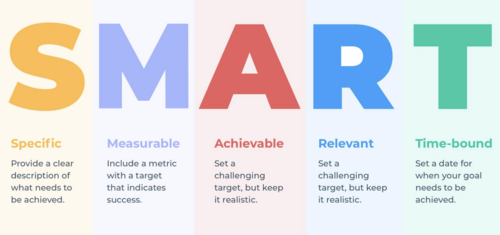SMART goals in project planning and performance management
(→Conclusion) |
|||
| Line 69: | Line 69: | ||
==Conclusion== | ==Conclusion== | ||
| + | ''It is important to note, while the exact definition of “R” is not critical, it should be meaningful and not redundant in a larger context.''(achieveit) | ||
==Annotated bibliography== | ==Annotated bibliography== | ||
<references/> | <references/> | ||
Revision as of 08:15, 21 September 2017
>>>Work in progress<<<
Considering the obstacles an effective goal setting can encounter such as lacking organisational capabilities or resistance to change, e.g due to individual anxiety, creating and implementing appropriate goals seem to be challenging. However, in a dynamic company environment establishing effective goals followed by developed action plans is of great importance in any project management process. Initially created by George T. Doran in the Management Review[1], the SMART goals can be classified as an effective goal setting technique. The acronym SMART stands for: Specific, Measurable, Achievable, Relevant, Time bound.
Being in line with the purpose perspective of projects, this goal setting method is not only applicable in professional projects, but also in any project of private nature. Using this tool allows to generate success substantially related to its original efforts, which is of high value for any project manager. Due to the SMART goals' great scope in diverse industrial areas, a deep investigation of the SMART traits and simultaneously a critical reflection of its potential limitations will be conducted as follows.
Contents |
Introduction to goal setting
Organisations such as companies aim to create benefits and to reach outcomes or goals, respectively[2]. This process is often initiated by establishing a vision which is translated into measureable goals in the project planning phase on an organisation's strategic, tactical or operational level. Next to the performance evaluation of the proposed goals, goals create a direction(QUELLE-MANAGEMENT REVIEW) which allows to be followed throughout the phases of any project management process[3].
As any managerial task such as a planning process is accompanied by uncertainties[4] that can lead to ambiguity and fallacy, an effective way of setting achievable goals is absolutely essential(QUELLE finden, wo es angesprochen wurde!!!!!) to mitigate negative outcomes(AUSDRUCK).
for success validation necessary
goals also for further development necessary (next to direction) (QUELLE-Managementreview)
defined goals/objectives are in the scope category of project, program and portfolio mgmt (SPM p7)
ADD more about Goals vgl SPM
History of goals -> great organisational performance In the 1960’s, research began regarding the power of setting goals and organizational performance. The first contextual event in the history of SMART goals happened in 1968. Dr. Edwin Locke published a seminal paper called “Toward a Theory of Task Motivation and Incentives”. In the paper, Locke established that appropriately set goals do result in superior organizational performance.(https://www.achieveit.com/resources/blog/history-evolution-smart-goals/)
Why SMART?
Initially created by George T. Doran in the Management Review[1], the SMART goals can be classified as an effective goal setting technique. The acronym SMART stands for: Specific, Measurable, Achievable, Relevant, Time bound.
Using this tool allows to generate success substantially related to its original efforts, which is of high value for any project manager.
establishing effective goals followed by developed action plans is of great importance in any project management process(QUELLE-MANAGEMENT REVIEW)
applicability in various industrial areas and project management areas >> figure to show scope
>> figure success rate after implementing smart goals towards w/o smart goals
can be implemented in any methodology (QUELLE)
executives. Leaders and managers are looking for a way to guide using smart goals(QUELLE achieveit)
Application: How to be SMART?
Guidance
provide template
Case studies
Project management phases: Planning, performance measurement, time management
>>industrial feedback after smart application<<
>>>Further consideration in program/portfolio management
Limitations
Bias, human resistance
effective goal setting can encounter such as lacking organisational capabilities or resistance to change, e.g due to individual anxiety (QUELLE-Managementreview)-requires critical reflection of capabilities and encountering unpleasant realisation of lacking capabilities
not easy to set appropriate goals (tbd- check QUELLE-Management review)
Other techniques?
goals not ambitious enough
strictly following of guidance can lead to disregard better solutions
Conclusion
It is important to note, while the exact definition of “R” is not critical, it should be meaningful and not redundant in a larger context.(achieveit)
Annotated bibliography
- ↑ 1.0 1.1 Management Review, 1981, http://community.mis.temple.edu/mis0855002fall2015/files/2015/10/S.M.A.R.T-Way-Management-Review.pdf, Retrieved September 20, 2017
- ↑ PMI, The Standard for Project Management, 2013, p26-29
- ↑ PMI, XXX, https://www.pmi.org/learning/library/project-management-middle-five-stages-6969, Retrieved September 20, 2017
- ↑ Gareth R. Jones, Essentials of Contemporary Management, 2015, p9
- ↑ Megan M. Flores, 2017, https://www.achieveit.com/resources/blog/history-evolution-smart-goals/, Retrieved September 20, 2017